McGirk Exclusive: Tracks Like Giant Gorilla’s
Posted by: Loren Coleman on April 6th, 2006
“Myths do not leave footprints,” Vincent Chow told the media at the end of March 2006.
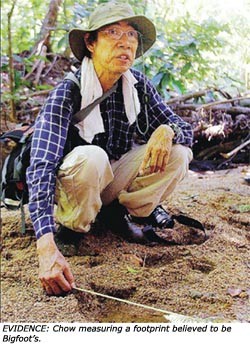
A new expedition is in the works, and certainly there are no shortage of tracks being found in Malaysia. But who has been finding them, and where? And what do they say they look like, beyond the media hype? Today we take a moment to straighten out a bit of recent history from an informed point-of-view.
In an exclusive interview with Jan McGirk, Southeast Asia Correspondent to the British newspaper, The Independent, Cryptomundo has obtained new details about the finds of “Bigfoot” tracks on the recent high-profile Malaysian expedition.
Less we forget, it was McGirk who has been filing some of the most in-depth articles out of Johor, giving names and dates about sightings when the routine articles have merely been listing vague “old reports” of creatures in the woods.
For example, on January 29, 2006, in her article in The Independent, McGirk wrote:
Last August [2005], a frog catcher from the Orang Asli tribe claimed he encountered an auburn-haired tropical Yeti scratching itself on a tree. Hamid Mohd Ali, 31, stopped about 30ft short of the creature which was twice his height. “I could see its teeth but I did not wait to find out if it was smiling at me or whether it saw me as its meal,” he said. “In this year alone, four villagers have claimed to have seen it and we think this is because of the shrinking jungle.”
…Malaysia, where tribal people call the creatures…Mawas, or Hantu Jarang Gigi, (“snaggle-toothed ghost”), will be the first country openly to endorse an official attempt to track them down.
Therefore, this week, I discussed with McGirk the background on these cryptid incidents. Well-publicized Johor tracks have been found. Personalities and various organizations were involved, not unlike what many of us are familiar with in the States. I wanted a sense of what was happening from someone there. Here’s what McGirk told me:
That intriguing Johor cast was taken from an impression in the soil by the Singapore Paranormal Investigators, a group of volunteer researchers, while three of their team were in southern Malaysia on 20 February 2006.
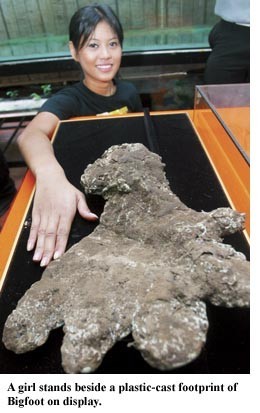
It was their second day-trip to check out reported sightings of “Bigfoot” (called “Mawas” by traditional Malaysians). They encountered Kong, a local construction worker who spoke some Mandarin, and he told them about outsize tracks he had noticed on a newly tarred road near Bukit Lantang. Photos of these had been featured in local newspapers.
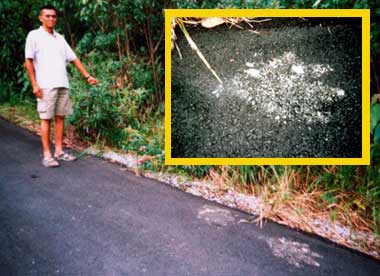

The SPI then followed him to this place, along with five paranormal researchers from Kuala Lumpur. I was there on assignment for a UK newspaper, The Independent, to report about the hunt for 10 foot ape-like creatures, and brought along Tony Burke, a trusted Australian friend who happens to be an outdoorsman with forest tracking experience. Mandt Bros productions of Los Angeles sent a film crew out with the team from Kuala Lumpur. A Malaysian security guard/fixer accompanied them.
Our rather large group searched the privately-owned woods near the road for more than 90 minutes, but not very methodically. Lots of footage was recorded by the research teams and the show crew. Just before dusk, after some showers let up, Josh Gates followed me off trail and we spotted what looked like a fresh track with rounded toes.
It resembled a gorilla footprint, only far bigger. Gates touched it, and I noticed thrashed branches directly overhead plus a dent in an adjacent log, about two big strides uphill from the print.
I did not notice any strong smell of (Bigfoot) body odor nor did anyone find obvious hairs, fur, or droppings. We summoned the others quickly, because SPI had a police evidence kit for making a cast and the light was beginning to fade.
The casting process was filmed by the Mandt Bros productions crew. Their program’s narrator, Gates, was on camera throughout, explaining what was going on. He personally lifted the cast from the soil (with care because there appeared to be an abnormally deep heel print).

Gates posed with it, presumably for publicity stills, and snapshots were taken by the researchers.
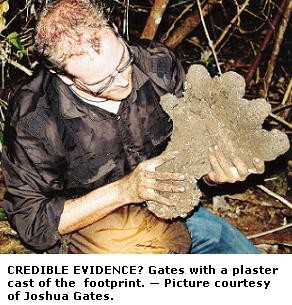
This discovery was a cooperative effort, and certainly would have been impossible without SPI, who brought the kit, the technician, and the Mandarin interpreter. The Malaysian researchers translated crucial directions and had robotic equipment at hand.
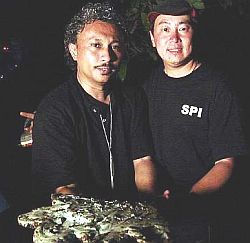
Exciting Find: Syed Abdullah (left) and Dr. Kenny Fong with the cast of a footprint which is believed to belong to an unknown hairy hominoid.
We all await the results from any scientific tests done on this unusual cast. Unfortunately, the original footprint was destroyed in the process of lifting the cast free. SPI agreed to leave the footprint cast in Malaysia and entrusted it to the crew from Kuala Lumpur.
About Loren Coleman
Loren Coleman is one of the world’s leading cryptozoologists, some say “the” leading living cryptozoologist. Certainly, he is acknowledged as the current living American researcher and writer who has most popularized cryptozoology in the late 20th and early 21st centuries.
Starting his fieldwork and investigations in 1960, after traveling and trekking extensively in pursuit of cryptozoological mysteries, Coleman began writing to share his experiences in 1969. An honorary member of Ivan T. Sanderson’s Society for the Investigation of the Unexplained in the 1970s, Coleman has been bestowed with similar honorary memberships of the North Idaho College Cryptozoology Club in 1983, and in subsequent years, that of the British Columbia Scientific Cryptozoology Club, CryptoSafari International, and other international organizations. He was also a Life Member and Benefactor of the International Society of Cryptozoology (now-defunct).
Loren Coleman’s daily blog, as a member of the Cryptomundo Team, served as an ongoing avenue of communication for the ever-growing body of cryptozoo news from 2005 through 2013. He returned as an infrequent contributor beginning Halloween week of 2015.
Coleman is the founder in 2003, and current director of the International Cryptozoology Museum in Portland, Maine.










Still look like over-lapping rhino prints to me. Look closely at the leftmost toe, and you will see the other two faintly in the heel of the forward print.
Which is still very significant, they are very close to being extinct.
I don’t know about Rhino tracks, but the heel looks really narrow in comparison to the rest of it. Also, it isn’t shaped much like any North American Bigfoot track casts that I’ve seen.
Good evening Bigfoot Bloggers…
If those are real footprints…our beloved North American Sasquatch may have a big brother in SE Asia…
They looked like Godzilla tracks to my ole beady eyes….
seeing is believing…
ole bub and Toshiba the Samurai dawg
I am wondering how the term ‘Bigfoot’ got into this. Grant it the cast is large, But I suspect some one needs to do a bit more research before starting to throw around what must seem obvious names. I understand there are several varities of ‘Large hairy Homids. Just a little too culture crossing for me.
Please click the “Malaysian Bigfoot” reference point along the right hand side of the page. There you will find various discussions of the “naming” of these creatures.
In general, since the late 1950s, the use of “Bigfoot” has been widespread by the media to denote any large hairy unknown bipedal primate seen anywhere around the globe.
However, in my field guide and other writings, I discuss how there are more than one type of unknown hominoid.
“Bigfoot” has become a term that hides more than it enlightens.